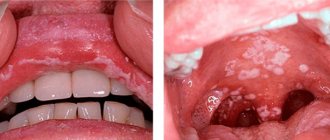- What is included in the rehabilitation
- Stages of a full range of events
- What is a certificate from a dentist about oral hygiene?
- Certificate of oral hygiene during pregnancy
- Certificate on oral sanitation for children and adolescents
- Where can I get a certificate of oral hygiene?
Sanitation of the oral cavity is a set of measures for the diagnosis and treatment of dental pathologies. It allows you to promptly detect problems with teeth and gums and effectively eliminate them in the early stages. Various institutions may require a certificate of oral sanitation, which can be purchased at the reliable A-Medic clinic. Let's take a closer look at how oral cavity sanitation is carried out and what the certificate is.
How to get a certificate of oral sanitation? | Dentistry As-Stom | St. Petersburg (SPb)
Ask a question to the doctor
A certificate of sanitation of the oral cavity is a document that is often required before serious surgical interventions, the child’s admission to kindergarten or school, before a long business trip or travel during which dental treatment is not possible, or before performing a certain type of work (for employees harmful chemical or food production, for example). What lies behind the words “oral sanitation” and what exactly needs to be done to get the coveted certificate?
Why is an examination needed?
In childhood, a checkup with a dentist is necessary for parents to monitor the normal development of the child and timely elimination of emerging problems.
An adult should also undergo regular examinations by specialists at a dental clinic. The condition of the oral cavity is direct evidence of the normal functioning of the body.
For an employer, a certificate from a dentist is one of the documents that confirms the health of employees. Everyone wants to see strong people on their staff who will not spend most of their time on sick leave.
What is oral sanitation?
Sanitation (from the Latin sanatio - treatment, recovery) is a whole range of measures aimed at eliminating disorders and diseases of the oral cavity and general dental health. In other words, this is everything that is required to maintain healthy teeth.
Oral sanitation includes:
Professional teeth cleaning (removal of tartar and plaque, cleaning of interdental spaces)
Treatment of dental caries (all carious cavities, as well as the initial stage of caries)
Treatment of complications of dental diseases ( pulpitis , periodontitis )
Prosthetics and implantation of missing teeth
Removal of damaged or hopelessly diseased teeth
Elimination of foci of infection (treatment of gums and inflammation in the oral cavity)
Correction of deformed teeth and orthodontic treatment
Thus, about a patient who has undergone complete sanitation of the oral cavity, we can say that from a dental point of view he is a relatively healthy person, and he has taken all measures to prevent diseases of the teeth and gums.
What is included in the rehabilitation
It is recommended that every person undergo therapeutic and preventive health measures once every six months. This will allow you to promptly detect and eliminate carious lesions and other problems at an early stage, avoid sudden toothaches and keep your teeth healthy. Upon completion, a certificate of oral sanitation is issued. There are four forms of treatment and preventive measures:
- one-time For example, to register a child for school or to find a job;
- individual. A person, on his own initiative, turns to a dentist to assess the condition of the oral cavity and, if necessary, undergo a set of medical procedures;
- periodic. For some people, sanitation is a mandatory procedure (in accordance with the medical examination plan);
- planned (therapeutic and prophylactic). It is prescribed to check the condition of teeth and gums to maintain optimal levels of oral health. Routine inspections are carried out in schools and preschool institutions, and at many hazardous industrial enterprises.
There are no contraindications to sanitation. In the presence of some chronic diseases, it is carried out more often than once every six months. This applies to people suffering from diabetes, tonsillitis, asthma and cardiovascular pathologies. Therapeutic and preventive measures may include the following manipulations:
- treatment of various diseases of the oral cavity (in particular, elimination of carious lesions);
- removal of molars and premolars;
- restoring the integrity of the dentition using fillings (and in some cases, prosthetics);
- elimination of inflammatory processes;
- removal of tartar and plaque (via ultrasonic cleaning);
- correction of malocclusion.
How is oral sanitation performed?
Sanitation of the oral cavity can be a rather lengthy process - especially if the oral cavity is in a neglected state, and teeth will need to be treated in several steps, for example, with prosthetics or pulpitis. Therefore, if you need a certificate of sanitation at a certain point, you should take care of going to the dentist in advance and determine what procedures and in what quantity will be required, and what amounts will have to be spent on treatment.
Therefore, sanitation always begins with an examination by a dentist-therapist and the prescription of treatment. At this stage, an orthopantomogram of the teeth (panoramic X-ray image of the oral cavity) is taken, which makes it possible to accurately determine all diseases, including “dormant” ones, such as a maturing dental cyst .
Certificate of completion of oral cavity sanitation
If you plan to go for an inspection outside of working hours, you will not need a certificate. If you were referred to a dentist by a therapist, a gynecologist from a antenatal clinic or other official institutions (including an employer’s organization), you should take a medical form from the doctor confirming that you were examined.
On our website you can buy a dental certificate at a very attractive price. The courier will deliver the medical form within 24 hours from the date of application.
We guarantee complete confidentiality of your data and 100% legality of the certificate. All seals, stamps and signatures are affixed by real doctors. When you provide such a document at work, you will not have any questions.
All you need to do is call us at the numbers indicated in the header of the site or fill out the feedback form. In the second case, we will call you back within a few minutes, discuss all the formalities, and you can ask any questions about the preparation of the document. And on the same day you will receive a certificate.
Sample certificate of oral sanitation
The first line indicates the number of the certificate issued. On the second, the doctor writes the patient’s first, last and patronymic names. The third indicates his age and who issued the certificate. Next comes a column to indicate the conclusion and recommendations. The doctor puts the date of issue at the bottom left and his signature on the right.
Sanitation of the oral cavity is a fairly important measure, which is prescribed in many cases. A certificate of its completion may be needed upon admission to kindergarten, school, universities, before surgery, during pregnancy and before childbirth. The main task of sanitation is to identify problems with teeth or gums. If they are detected, the doctor prescribes the necessary treatment measures.
{SOURCE}
Reasons for obtaining help
In addition to preventive examinations for personal purposes, you may need to obtain a certificate from a dentist in the following cases:
· the entire period of bearing a child. In this case, it is very important for a woman to maintain her body in perfect order;
on the eve of surgery. Any operation is a powerful stress and burden on the body, so it is extremely important to undergo a full examination;
· admission to an educational institution. Every child is examined by a dentist annually;
· annual professional medical examinations for employees in all areas of activity.
Cavity sanitation is especially necessary for people whose activities involve harmful and difficult working conditions.
When might a certificate be needed?
Oral sanitation is a procedure that absolutely everyone, young and old, undergoes. Therefore, it can be requested for various purposes.
- Pregnancy. The antenatal clinic must refer you for examination to a dentist upon registration. This is done in order to prevent many unpleasant consequences that can happen to the oral cavity during pregnancy due to changes in hormonal levels.
- Help before childbirth. I send the woman to the maternity hospital, the local gynecologist who managed the pregnancy again sends the patient for sanitation.
- Without this certificate, the child will not be accepted into any educational institution, from preschool to higher and vocational.
- Those who are about to have a planned operation will also have to visit the dentist to get the coveted opinion.
- An annual medical examination is also not complete without a dentist’s note.
- People who work in some kind of hazardous environment or in production where dental pathologies can develop. In other words, all employees of chemical plants, as well as in confectionery shops, must be regularly examined by a dentist.
How does the receiving procedure work?
The work of clinics is regulated by orders of the Ministry of Health. X-rays may be needed to obtain a certificate. This procedure is paid even in government institutions. The dentist fills out all the necessary documents after work. Therefore, it will not be possible to quickly obtain a stamped certificate.
The process can drag on for a long period, depending on the initial condition of the teeth and the workload of the doctors. Sometimes this takes several weeks.
After examining the patient, the doctor fills out a form in writing with the stamp of the medical institution. At the last stage, a stamp is placed.
Stages of a full range of events
A full range of treatment and preventive measures consists of the following stages:
- examination by a dentist;
- identifying a problem and making diagnostic assumptions about the need to solve it;
- taking an x-ray of the problem area;
- ultrasonic cleaning, removal of plaque and tartar;
- drawing up a plan for further therapy (if necessary);
- referral for consultations to highly specialized specialists, for example, surgeons or orthodontists (if occlusion disorders and other specific problems are detected);
- carrying out health procedures;
- coating of teeth with a special gel polish, which contains calcium and fluoride;
- providing an opinion from a specialist;
- drawing up an individual additional schedule of visits (if necessary).
Average caries
An example of an entry in a medical record for moderate caries at a dentist’s appointment. The stages of treatment for moderate caries are also written. The template is ready to be filled out, in some cases it is necessary to highlight only one required option.
Date of: ____________________________
Complaints: no, fleeting pain from sweets and cold in the _______________ tooth
applied for rehabilitation
Anamnesis:
_____
tooth was not previously treated, was treated for caries, the filling fell out (partially fell out), __________ cavity was noticed ___________________________ ago, did not seek help
Objectively:
There are no external changes in the maxillofacial area, the lymph nodes are not enlarged. Opening the mouth is not difficult. The mucous membrane of the oral cavity is pink, moderately moist.
On the _____ surface of the _____ tooth, a filling, a carious cavity of medium depth, filled (partially filled) with filling material. Probing the walls is painful (mildly painful), percussion is painless. The reaction to cold is painful (mildly painful), and passes quickly.
GI = _______________, EDI _____________________
Diagnosis:
Moderate
caries ______________ tooth, class(es) according to Black ______ ICD K02.1
Treatment:
professional dental hygiene with preventive paste,
removal of a filling, preparation of a carious cavity, under infiltration, conduction anesthesia Sol. ___________________________
Drug treatment. 0.05% chlorhexidine solution,
air drying
Insulating gasket ____________________________________________________________
Restoration of the anatomical shape of the tooth _____________________________________________
Grinding, polishing with super polish paste
Remineralizing therapy ___________________________
Isolation of the filling with axil paste.
Recommendations: refrain from eating for two hours
What is the difficulty in registration?
There may be some difficulties on the way to obtaining a document confirming the satisfactory condition of your teeth. For example, a certificate is needed to enroll a child in an educational institution urgently, but the doctor discovers some kind of disease. Treatment can take a very long period. During this time, another may be accepted to take your child's place.
Or, people who do not undergo a professional examination in a timely manner may simply not be allowed to perform their work duties.
Video on the topic:
Where can I get a certificate?
To obtain a certificate, you need to contact the clinic at your place of residence, or a dental clinic.
You make an appointment with a specialist and undergo a full oral examination. If the doctor does not see any problems with your teeth, then you will be able to receive a certificate on the day of your visit. When you need treatment, you will be given a document upon completion. Some difficulties may arise in the process of obtaining a certificate. If, for example, you register your child for kindergarten, and a certificate is not issued because treatment is necessary, your place may be taken. In order to avoid such a problem, you need to visit the dentist in a timely manner and properly care for your teeth and oral cavity, then you will not have to wait long to receive the necessary document.
Now it is possible to order a certificate as quickly as possible, but you need to submit an application, come for an examination at a convenient time for you and receive the long-awaited document. At the moment, getting a certificate from a dentist is absolutely not difficult; this can be done both in a public clinic and in a private dental clinic. The procedure for obtaining a certificate can last from several hours, it all depends on the health of your teeth and oral cavity.
Based on materials from the site: https://spravka-stomatolog.com










